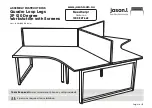
RTC
®
5 PC Interface Board
Rev. 1.9 e
9 Programming Peripheral Interfaces
203
innovators for industry
9
Programming Peripheral Interfaces
Scan systems are often used in equipment that needs
to synchronize processing by the laser and scan
system with other process steps (e.g. workpiece
placement, robotic motion, process monitoring etc.).
For this purpose, the RTC
®
5 provides a variety of
peripheral interfaces (see
). With the
commands for programming these interfaces, you
can supplementally and/or synchronously control the
following in addition to lasers and scan systems:
• Signals transmitted for peripheral control
• Querying and evaluation of peripheral signals
• Control and synchronization of laser scan
processes and peripheral control via external
control signals
This is described in the following sections.
9.1 Signal Output
For peripheral control (e.g. controlling a workpiece
transport system or a shutter), appropriate signals
can be outputted by the interfaces described below.
The output values can be changed at any time via
control commands or – during processing of a list –
via list commands.
9.1.1 16-Bit Digital Output Port
The EXTENSION 1 connector provides a buffered
16-bit digital TTL output (DIGITAL OUT0 … 15). The
level of its output signals must be configured with a
jumper (see
).
The
,
commands specify the digital output values. The
output is in high-impedance mode (tri-state) until an
initial value is assigned to it. In addition, the
command
Port
= 3) can be used
to define the value to be outputted at the 16-bit
digital output port, as soon as processing of a list has
ended with
or via an external stop
signal. The default value also takes effect together
with the position- and/or speed-dependent laser
control (see
If automatic laser control is activated, then the value
at the 16-bit digital output may automatically get
adjusted (see
). You can log this via
.
When the output value is changed, a LATCH signal is
outputted at the EXTENSION 1 connector as a trigger
signal for synchronization of data transmission.
command reads the current value
of the digital output port.
















































